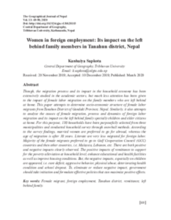Abstract
Though, the migration process and its impact in the household economy has been extensively studied in the academic sectors, but much less attention has been given to the impact of female labor migration on the family members who are left behind at home. This paper attempts to determine socio-economic structure of female labor migrants from Tanahun District of Gandaki Province, Nepal. Similarly, it also attempts to analyze the causes of female migration, process and dynamics of foreign labor migration and its impact on the left behind family specially children and elder citizens at home. For this purpose, 180 households have been purposefully selected from three municipalities and conducted household survey through snowball methods. According to the survey findings, married women are preferred to go for abroad, whereas the age of migration is after 30 years. Literate are very less migrated for foreign labor. Majority of the female migrants preferred to go to Gulf Cooperation Council (GCC) countries and then other countries, i.e. Malaysia, Lebanon, etc. There are both positive and negative impacts clearly observed. The positive impacts of remittance to support for the poverty alleviation at household level, enhance educational and health facilities as well as improve housing conditions. But, the negative impacts, especially on children are appeared, i.e. care deficit, aggressive behavior, physical abuse, deteriorating health condition and school dropout. To, eliminate or reduce negative impact, government should take initiation and formulate effective policies that can maximize positive effects.

